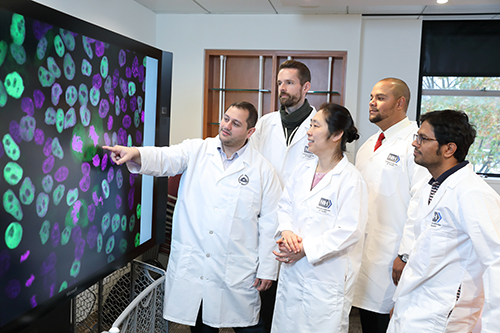Oral Health in America - December 2022 Bulletin
Section 6 Summary
Emerging Science and Promising Technologies to Transform Oral Health

Over the past 20 years, fundamental discoveries on the microbiome, genomics, regenerative medicine, materials science, and others have generated new insights into oral health and disease. At the same time, developments in data science and computer science, including big data and artificial intelligence, present opportunities to adopt person-centered oral health care approaches and to guide decision making by researchers, policymakers, clinicians, and individuals. Scientific and technological progress generates knowledge that will ultimately improve the nation’s oral and overall health and well-being.
Status of Knowledge, Practice, and Perspectives
Science and technology have fostered new insights into a spectrum of conditions, including tooth decay, gum disease, craniofacial disorders, head and neck cancers, and salivary gland dysfunction. However, achieving oral health for all requires translating basic research discoveries into clinical applications and implementing them across highly diverse populations. A growing body of research addressing communities’ social, economic, and environmental influences can inform efforts to help reduce health disparities. As new discoveries emerge, access must be made available and health equity must be achieved.
Advances and Challenges
Discoveries in genetics have shed light on the causes of some oral and craniofacial conditions, while advances in microbiology have shown how microbes can influence health and disease. Stem cell research and materials science have spurred development of regenerative approaches in dentistry. Digital workflows and data science platforms such as telehealth and electronic health records can facilitate collaborations among the health care system, government, nonprofits, and other entities to devise new strategies for improving oral health at the population level. Advances in artificial intelligence, 3D printing, and digital imaging are also reshaping oral health care. While scientists are making strides in research, there is a need to validate new technologies, engage communities in the research, and collect molecular and population-level data to ensure optimal outcomes.
Dental care and oral health research nearly halted at the beginning of the COVID-19 pandemic, creating unprecedented challenges. Moving forward, in the face of emerging threats from pathogens and environmental toxins, dental practitioners and researchers will need to be prepared to embrace new methods that reduce pathogen spread, to swiftly orchestrate scientific research, and to develop and implement science-based approaches that allow performance of safe patient care.
Promising New Directions
Scientific advances alone are not enough to improve the nation’s oral health, but translation of basic discoveries into clinical practice bring us closer to that goal. Practice-based research networks, which draw from the day-to-day experiences and insights of practitioners, patients, clinical researchers, and health organizations, are designed to facilitate the adoption of evidence-based research into the standard of care. Implementation research can be used to find ways to improve access to oral health care and enhance effectiveness of interventions.
Additional Takeaways
The future of dental care and improvements in oral health will depend on deeper insights into oral-systemic connections and development of more effective interventions. Such work will require collaborations across medicine, engineering, dentistry, and other areas. Oral health research is a significant driving force for clinical decision making and standards of care. Sustaining scientific advancement and implementing effective and accessible clinical care will depend on how today’s professionals shape dental education and the research landscape.
Q&A with Section Editor
Q&A with Laurie McCauley, D.D.S., Ph.D., senior editor, Section 6: Emerging Science and Promising Technologies to Transform Oral Health
What are some important takeaways about this section?
There has been tremendous progress in cellular, molecular, and data science related to oral health and disease. Advances in the technologies and biomaterials that support clinical practice have dramatically improved diagnosis and treatment over the past 20 years. Health data analytics and electronic health records, which have the potential to integrate medical and dental care and foster insights into social determinants of health, have grown significantly and provide new opportunities to promote evidence-based care. There is a need for strategic deployment of technology and scientific advances to benefit all in our communities and to reduce health disparities.
What was a surprising finding?
It was surprising to have a new pathogen—SARS-CoV-2—arrive just as we were finalizing Section 6 of the report. It was nearly impossible to keep up with the pace of the science as the section was going through final proofs and approvals. It was a keen reminder of how important it is to continually build scientific foundations across the spectrum of disciplines that interface with oral health. Our profession weathered the storm of the pandemic better than feared thanks to years of solid research that was translated into practice in the areas of virology, infection control, and public health.
What should the American people know about this section of the report?
The Surgeon General’s report from 2000 provided a robust description of oral health at that time. This new report, for the first time, includes a dedicated section on the science and technology that will drive our profession to improve the health of our nation and beyond. It is incredibly exciting to provide a window into how we can tackle the problems outlined in earlier sections and further elevate oral health as central to overall health. This section presents elegant science in a manner that both lay readers and colleagues in science can appreciate. Research on the bacterial microflora that inhabit our oral cavity is unfolding in real time, creating a path for improved strategies to prevent and combat oral diseases. Evolving technologies are catapulting dentistry and dental hygiene far beyond where they were 20 years ago. Personalized health approaches based on data analytics and delivered with leading-edge digital platforms are making oral health care more affordable and accessible.
What is the main call to action?
The main call to action is to bolster and build our educational infrastructure to ensure we are training individuals with a foundation in the clinical issues of oral health and the scientific underpinnings to further our knowledge and discovery mission in oral health sciences. The number of schools and students in dentistry have increased over the past 20 years, but the number of graduate programs and research degree candidates has not kept up. Without dedicated efforts to train the future scientific workforce, the gap between the evidence and its translation to clinical care will widen. To achieve optimal oral and overall health, the scientific workforce needs to be developed, nurtured, and supported to deploy the latest and best science and technology for the good of all people.
Laurie McCauley, D.D.S., Ph.D., is a professor and the provost and executive vice president for academic affairs at the University of Michigan. She received her Doctor of Dental Surgery, doctorate, and master’s degree from The Ohio State University. For more than 20 years, Dr. McCauley has led an active research program studying the interactions between hormones and skeletal biology.
Did You Know?
- Technologies such as novel materials with regenerative properties, 3D-printed dentures, and artificial intelligence platforms for analyzing diseases and managing patient data are transforming dentistry. See context.
- Scientific innovation alone is not enough to achieve oral health for all; basic discoveries must be successfully translated into clinical practice. See context.
- Recent discoveries in genetics and microbiology are illuminating the connections between oral and systemic health and offer promise for personalized oral health care. See context.
- The COVID-19 pandemic nearly brought oral health care and research to a sudden, though short-lived halt, underscoring the need for a robust and flexible scientific community that can swiftly address emerging health threats. See context.
Learn more about Oral Health in America: Advances and Challenges
July 2024


